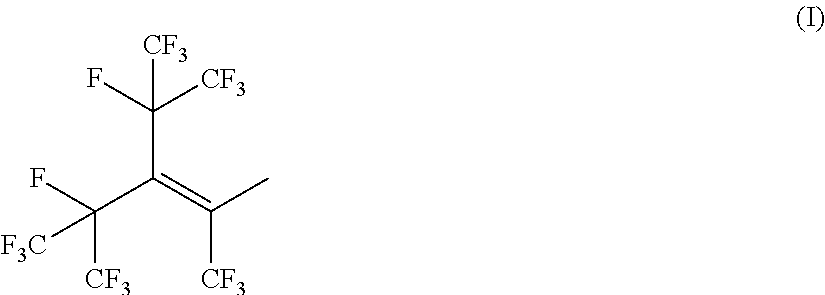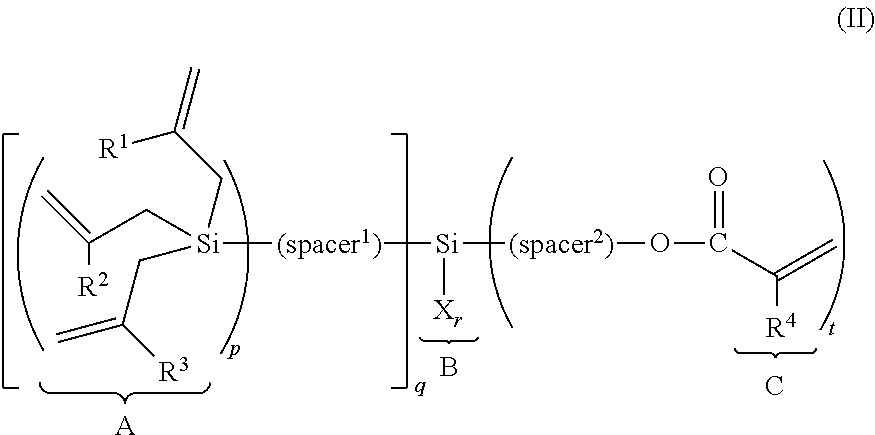(METH)allylsilane compound, silane coupling agent thereof, and functional material using the same
a technology of allylsilane and silane, which is applied in the field of meth-allylsilane compound, silane coupling agent thereof, and functional materials, can solve the problems of difficult purification of organic/inorganic hybrid materials, difficult stocked, and inability to perform desired silane coupling reaction with other functional groups, etc., to achieve easy hydrophilicity, high purity, and easy preparation
- Summary
- Abstract
- Description
- Claims
- Application Information
AI Technical Summary
Benefits of technology
Problems solved by technology
Method used
Image
Examples
example 1
[0156](1.1) Under a nitrogen atmosphere, to 1,4-dibromobenzene (1) (15 g, 15.9 mmol), cyclopentyl methyl ether (CPME) (90 ml) was added and cooled to around −10° C. using salt ice, tetrahydrofuran (THF) solution (iPrMgCl solution) of 2M isopropyl magnesium chloride (0.35 equivalents, 11.2 ml) and hexane solution (nBuLi solution) of 1.67M normal-butyl lithium (0.7 equivalents, 26.8 ml) were added dropwise. The mixture was stirred for 2 hours at −10° C. Then allyl bromide (1.1 equivalents, 6.8 ml) was added and stirred at room temperature for 14 hours. To the reacted mixture, diethyl ether was added and neutralized by adding saturated ammonium chloride. The obtained water layer was extracted by diethyl ether. The collected organic layer was washed with saturated saline solution, dried over anhydrous magnesium sulfate, then filtered and concentrated under reduced pressure, obtaining a crude product of 1-allyl-4-bromobenzene (2) (yield: 13.0 g, yield (%): 103%)
[0157]The physical and che...
example 2
[0179](2.1) To triphenylphosphine dibromide (447.5 mg, 1.060 mmol), distilled dichloromethane (5 ml) was added under a nitrogen atmosphere and dissolved. Then a solution prepared by dissolving 1-bromo-4-(diallylethoxysilyl)benzene (11) (300 mg, 0.9637 mmol) into distilled dichloromethane (1.5 ml) was added and stirred at room temperature for 12 hours. After stirring, diethyl ether solution of 1M allylmagnesium bromide (1.156 ml, 1.156 mmol) was added dropwise and stirred at room temperature for 5 hours. The reacted mixture is cooled down to 0° C. and diluted with water to stop the reaction. 10% hydrochloric acid was added until salt was completely dissolved. The obtained organic layer was separated and the obtained water layer was extracted with dichloromethane. The collected organic layer was each washed with saturated sodium bicarbonate aqueous solution and saturated saline solution in this order, and dried over anhydrous magnesium sulfate and then filtered and concentrated under ...
example 3
[0184](3.1) To triphenylphosphine dibromide (129.6 mg, 0.3070 mmol), distilled dichloromethane (2 ml) was added under a nitrogen atmosphere and dissolved. Then a solution prepared by dissolving 1-iodo-4-(diallylethoxysilyl)benzene (13) (100 mg, 0.2791 mmol) into a distilled dichloromethane (1 ml) was added, stirred at room temperature for 3 hours. After stirring, diethyl ether solution of 1M allylmagnesium bromide (0.6978 ml, 0.6978 mmol) was added dropwise, stirred at room temperature for 2 hours. The reacted mixture was cooled down to 0° C., then diluted with water to stop the reaction. 10% hydrochloric acid was added until all salt was completely dissolved. The obtained organic layer was separated and the obtained water layer was extracted with dichloromethane. The collected organic layer was each washed with saturated sodium bicarbonate aqueous solution and saturated saline solution in this order, then dried over anhydrous magnesium sulfate, then filtered and condensed under red...
PUM
| Property | Measurement | Unit |
|---|---|---|
| carbon number | aaaaa | aaaaa |
| temperature | aaaaa | aaaaa |
| volume average diameter | aaaaa | aaaaa |
Abstract
Description
Claims
Application Information
 Login to View More
Login to View More - R&D
- Intellectual Property
- Life Sciences
- Materials
- Tech Scout
- Unparalleled Data Quality
- Higher Quality Content
- 60% Fewer Hallucinations
Browse by: Latest US Patents, China's latest patents, Technical Efficacy Thesaurus, Application Domain, Technology Topic, Popular Technical Reports.
© 2025 PatSnap. All rights reserved.Legal|Privacy policy|Modern Slavery Act Transparency Statement|Sitemap|About US| Contact US: help@patsnap.com



